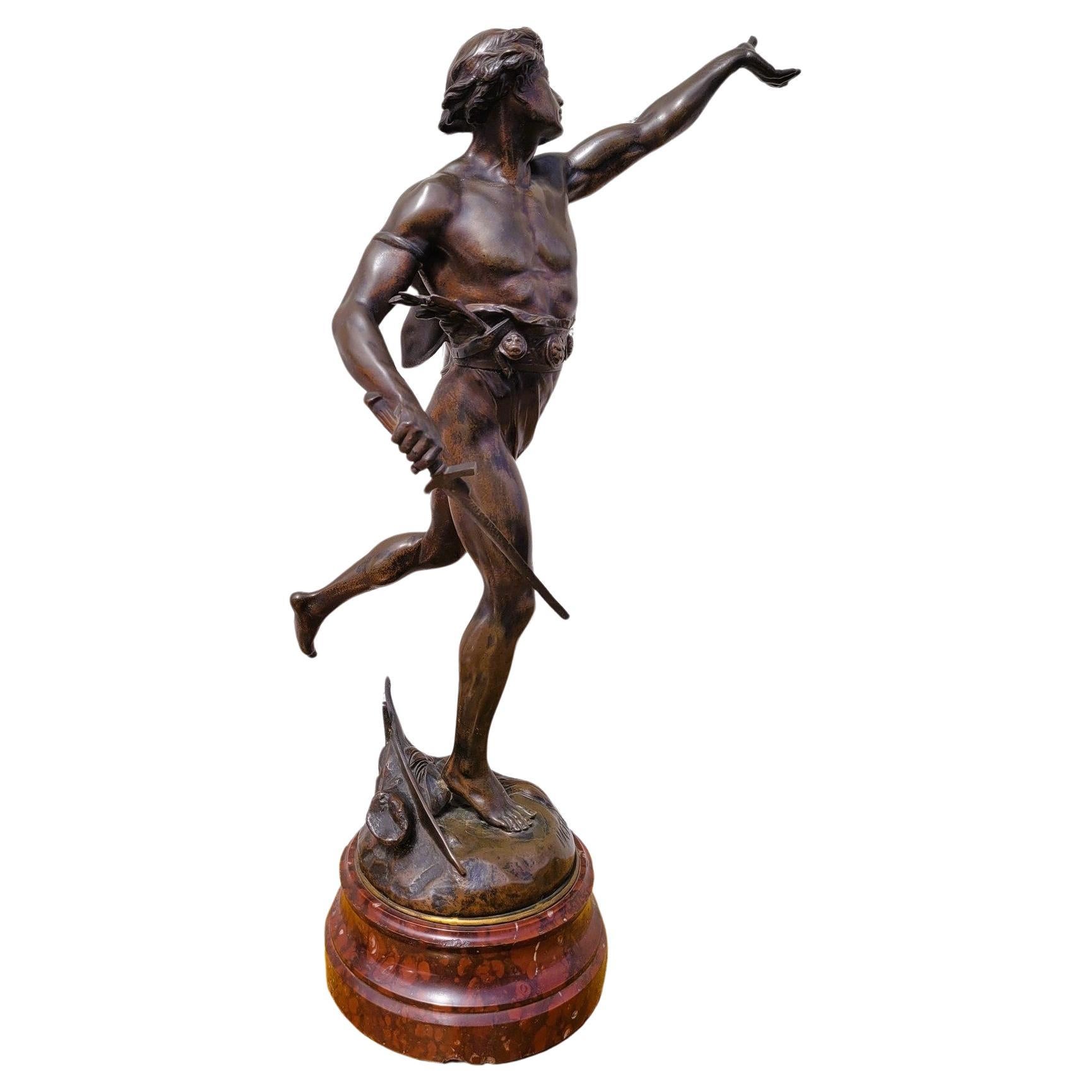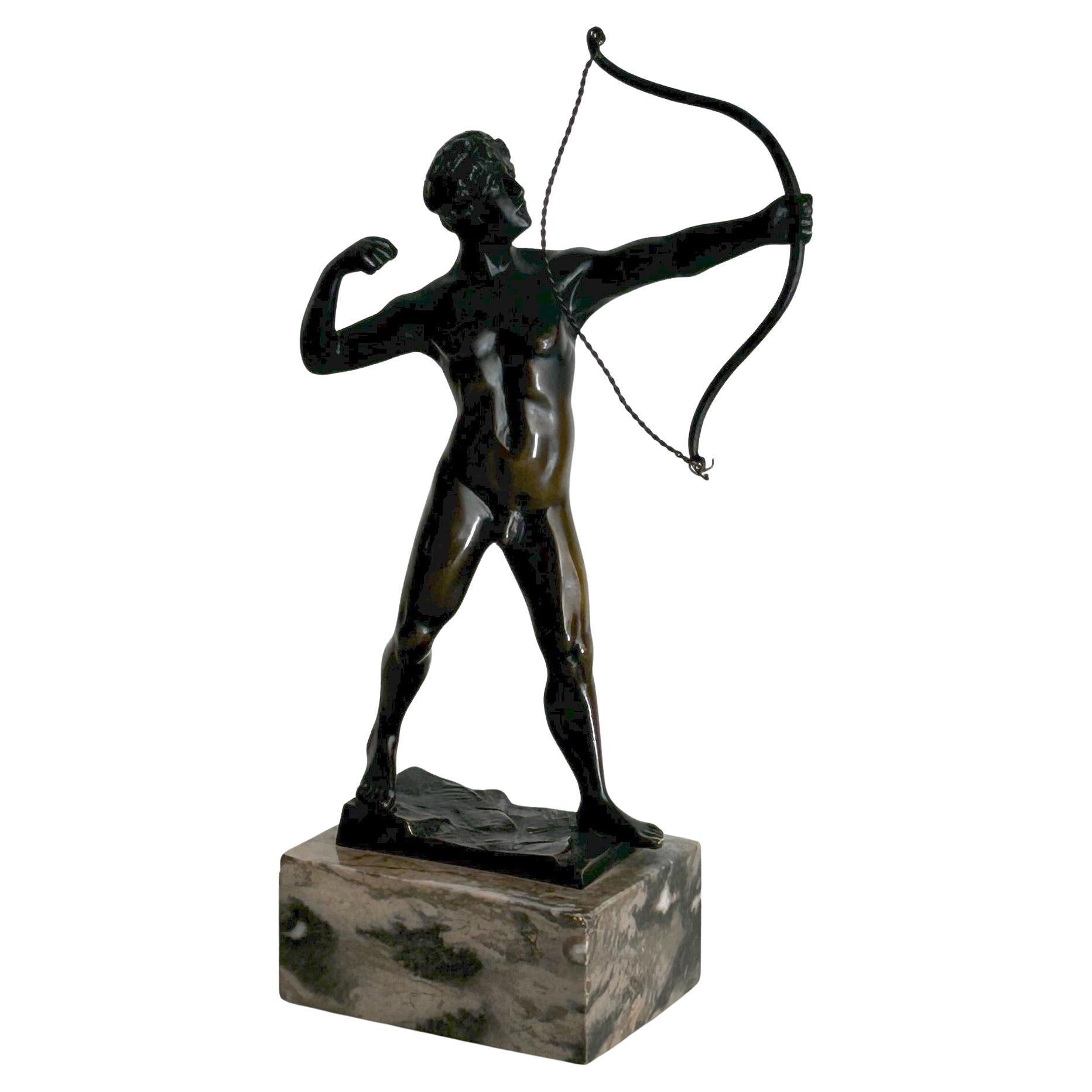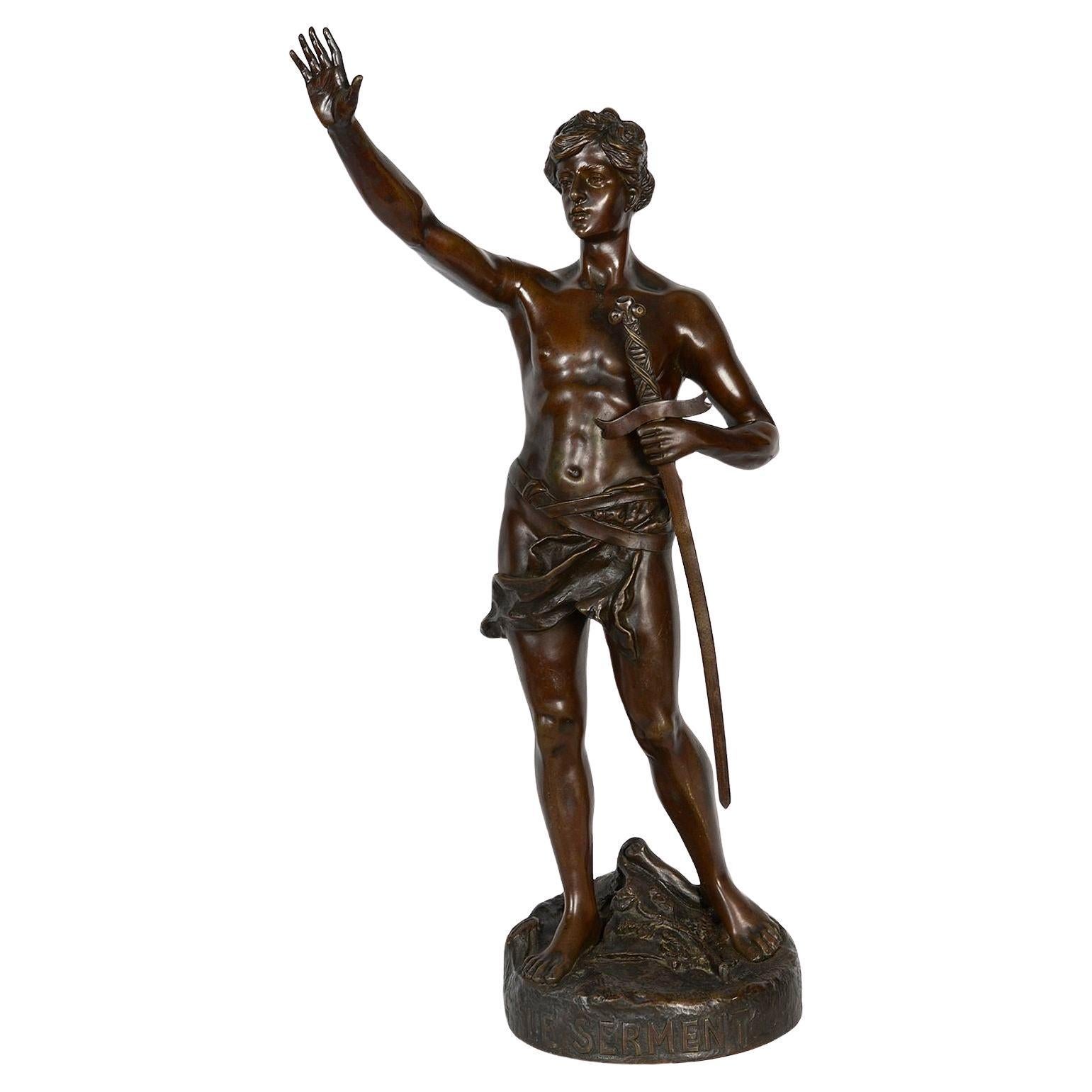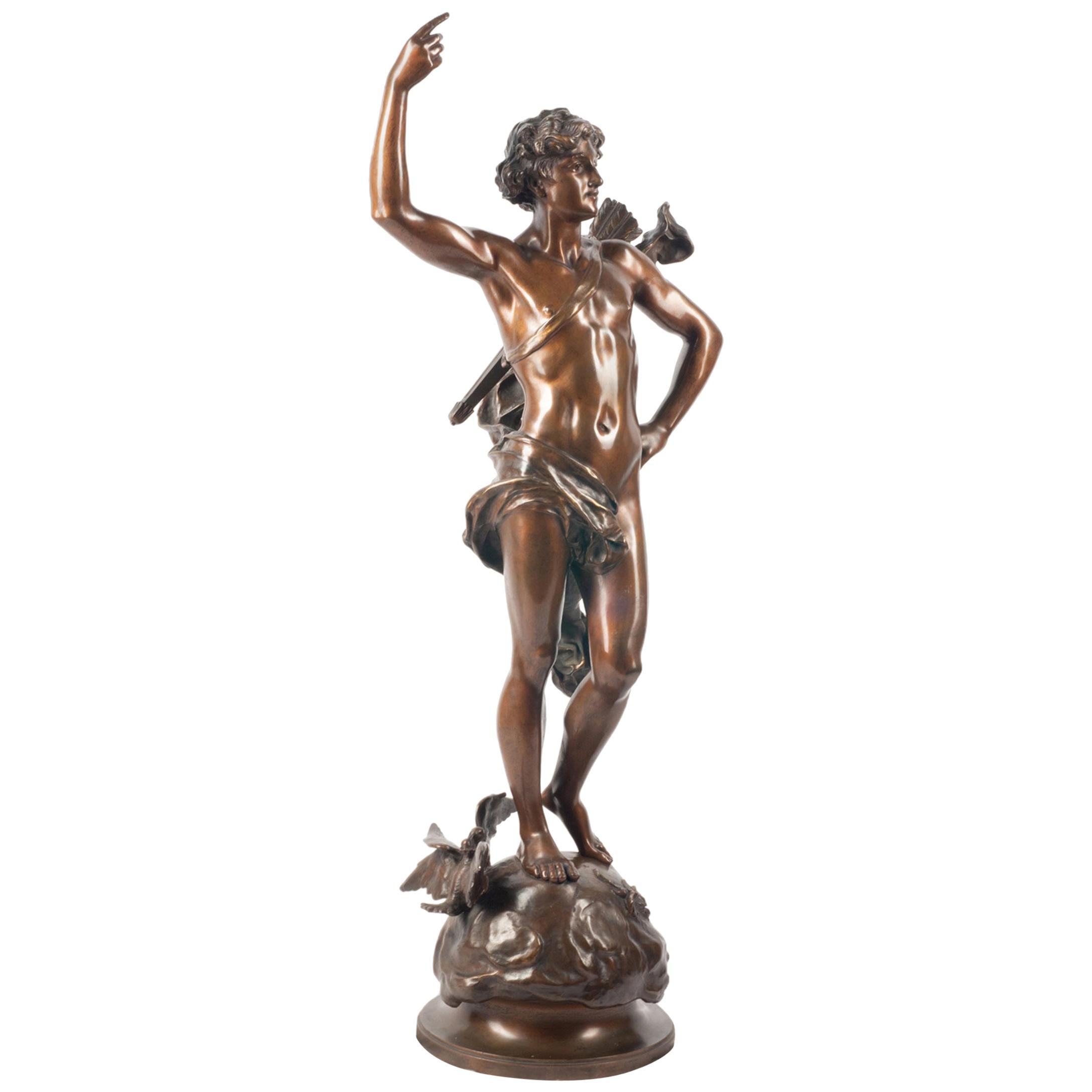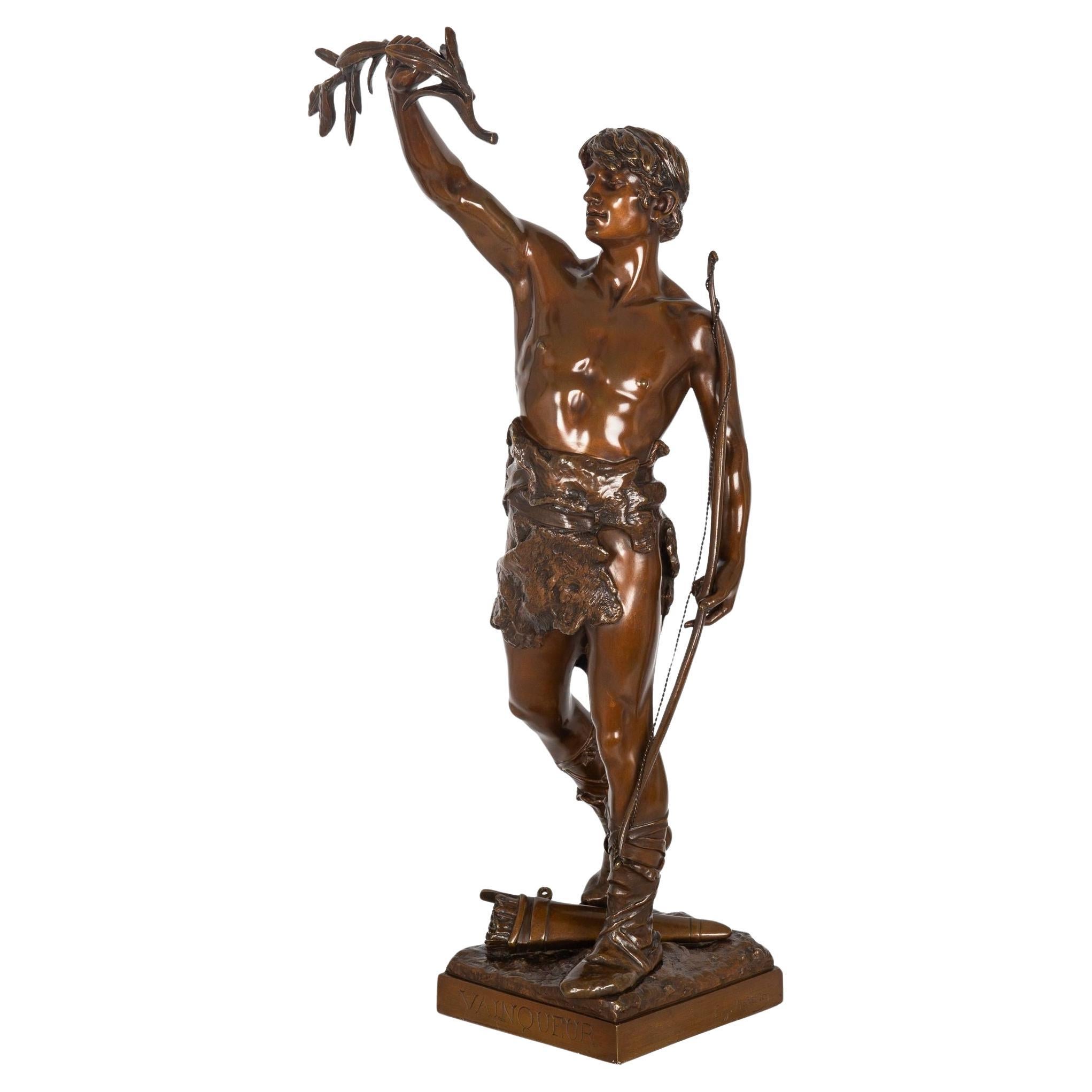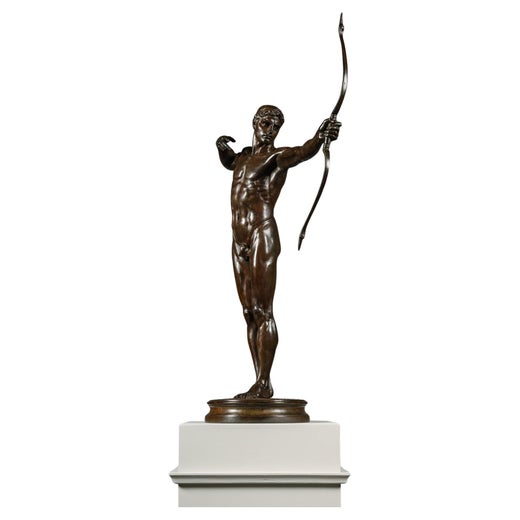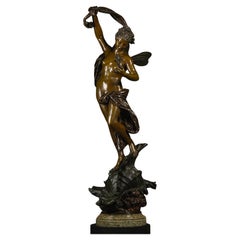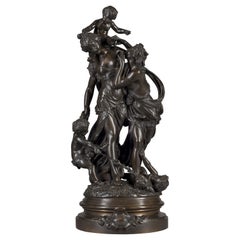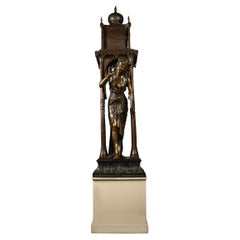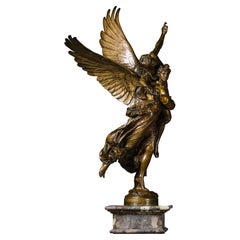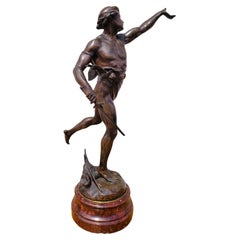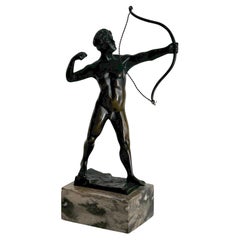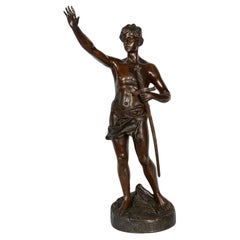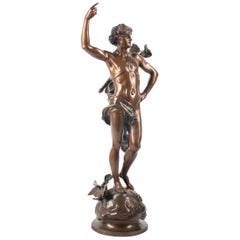Items Similar to A Patinated Bronze Statue Of Teucer, By Sir William Hamo Thornycroft
Want more images or videos?
Request additional images or videos from the seller
1 of 15
A Patinated Bronze Statue Of Teucer, By Sir William Hamo Thornycroft
$100,080.54
£72,000
€84,860.79
CA$136,057.19
A$152,401.54
CHF 79,231.86
MX$1,881,852.40
NOK 1,009,351.56
SEK 954,184.87
DKK 633,277.62
Shipping
Retrieving quote...The 1stDibs Promise:
Authenticity Guarantee,
Money-Back Guarantee,
24-Hour Cancellation
About the Item
Sir William Hamo Thornycroft (British, 1850-1925)
A Patinated Bronze Statue Of Teucer
The standing figure of the male nude holding his bow in his outstretched left hand, raised on a circular naturalistic base.
Signed and dated ‘HAMO THORNYCROFT 1881’, and numbered ‘14’ to the base.
The model conceived in 1881 and this bronze cast by the Singer & Sons Foundry, Frome, Circa 1900. Numbered ‘14’.
England, Circa 1900.
Provenance:
By repute bought from the artist.
A Private Family Collection, Aberdeenshire, Scotland, until sold in 2024.
When this sculpture was first exhibited at the Royal Academy in 1881, as a full-size plaster cast. it achieved great success. In 1882 a large bronze version was commissioned by the Trustees of the Chantrey Bequest for the Tate Gallery, London. In view of the success of this figure, Thornycroft cast the work as a bronze reduction during his lifetime. Thornycroft was personally involved in the casting process of his bronzes, working with Herbert Singer of Singer & Sons Foundry, Frome. The present statue, standing 30 inches high, is the larger of two reduced sized versions that were cast. The other being 17 inches high. Numbered ‘14’ the present example is also rare, numbered cast.
Teucer is a hero from Homer’s The Iliad. A half-brother of the Greek hero Ajax, he was considered the best archer amongst the Greeks fighting at Troy. He fought against his cousins Hector and Paris in the Trojan War, but he failed in his repeated attempts to strike Hector with an arrow, for Hector had the divine protection of Apollo. Thoryncroft depicts Teucer in this moment of intense concentration, as he fires one more thwarted arrow after Hector.
When the full-size plaster version was shown at the Royal Academy in 1881 a quotation from Pope's translation of Homer was printed in the catalogue because the subject was unusual.
Since, rallying, from our wall we forced the foe,
Still aimed at Hector have I bent my bow;
Eight forky arrows from this hand have fled,
And eight bold heroes by their points lie dead:
But sure some god denies me to destroy
This fury of field, this dog of Troy. [VIII, 359–64]
The Homeric theme dignifies Thoryncroft’s impetus to create a series of statues of Athletes engaged in English sports, primarily focusing on studies of the nude. 'Teucer' was modelled after the celebrated Italian life model Orazio Cervi, known for his 'perfectly proportioned physique'. The right-angled position, without precedent in classical or European sculpture, was an innovation which gave Thoryncroft’s archer a freshness of form.
“The typical Homeric bowman, entirely nude, and of heroic size. He stands scarcely relaxed from the rigid position in which he has drawn his great bow, but the arrow has actually started, and he follows its course with an attentive eye. The legs are drawn close together, and are still tense with the effort of resisting the opposite action of the arms, which are almost parallel to the ground. Nothing could be less conventional than this figure, which has something almost archaic about its serenity and rigidity” (Edmund Gosse, “Our Living Artists - Hamo Thornycroft A.R.A.” Magazine of Art 4 (1881), p. 331).
Chicago collector and philanthropist George A. Armour, who owned a small cast of the composition, commissioned a full-scale bronze cast from the artist in 1891 and immediately gave it to the Art Institute of Chicago (Teucer, 1881, cast 1891. 80 inches high ref. no. 1891.80).
Bronze examples recorded, 30 inches high:
1. The Harris Museum and Art Gallery, Preston, UK.
2. Detroit Institute of Arts, USA (ref. no. 81.703).
3. The Huntington Library, Art Museum, San Marino, USA, numbered ‘22’ (ref. no. 2007.6)
4. With Leicester Galleries, London, UK, numbered ‘13’.
-
Bronze examples known, 17 inches high:
1. The Royal Academy, London, UK, gift of Elfrida Manning, née Thornycroft (1901–1987), the artist's daughter. (ref. no. 03/2432).
2. Los Angeles County Museum of Art, USA (re. no. M.87.119.26)
Literature:
E. Gosse, “Our Living Artists - Hamo Thornycroft A.R.A.” Magazine of Art, London, 1881, pp. 329-32.
F. Wedmore, “Rising Artists.” The Gentleman’s Magazine, London, 1881, pp. 91-100.
E. Manning, Marble & Bronze, The Art and Life of Hamo Thornycroft, London, 1982, pp. 14-5, 17-8
S. Beattie, The New Sculpture. New Haven: Yale University Press, 1983, pp. 146-9, pl. 140.
British Sculpture 1850-1914. A loan exhibition of sculpture and medals sponsored by The Victorian Society. Exhibition catalogue. The Fine Art Society, London, 1968. no. 163.
Gibson to Gilbert: British Sculpture 1840-1914. Exhibition catalogue. The Fine Art Society, London, 1992. no. 55.
- Creator:William Hamo Thornycroft (Sculptor)
- Dimensions:Height: 30.32 in (77 cm)Width: 18.12 in (46 cm)Depth: 7.88 in (20 cm)
- Style:Neoclassical (In the Style Of)
- Materials and Techniques:Bronze,Patinated
- Place of Origin:
- Period:
- Date of Manufacture:Circa 1900
- Condition:Wear consistent with age and use.
- Seller Location:Brighton, GB
- Reference Number:Seller: B782111stDibs: LU1028044241252
William Hamo Thornycroft
William Hamo Thornycroft was an English sculptor, responsible for some of London’s best-known statues. He was a keen student of classical sculpture and became one of the youngest members of the Royal Academy.
About the Seller
5.0
Recognized Seller
These prestigious sellers are industry leaders and represent the highest echelon for item quality and design.
Established in 1964
1stDibs seller since 2014
58 sales on 1stDibs
Typical response time: 2 hours
Associations
The British Antique Dealers' AssociationLAPADA - The Association of Arts & Antiques Dealers
- ShippingRetrieving quote...Shipping from: Brighton, United Kingdom
- Return Policy
Authenticity Guarantee
In the unlikely event there’s an issue with an item’s authenticity, contact us within 1 year for a full refund. DetailsMoney-Back Guarantee
If your item is not as described, is damaged in transit, or does not arrive, contact us within 7 days for a full refund. Details24-Hour Cancellation
You have a 24-hour grace period in which to reconsider your purchase, with no questions asked.Vetted Professional Sellers
Our world-class sellers must adhere to strict standards for service and quality, maintaining the integrity of our listings.Price-Match Guarantee
If you find that a seller listed the same item for a lower price elsewhere, we’ll match it.Trusted Global Delivery
Our best-in-class carrier network provides specialized shipping options worldwide, including custom delivery.More From This Seller
View AllA Fine And Large Patinated Bronze Figure Of A Sea Nymph
By Luca Madrassi
Located in Brighton, West Sussex
Luca Madrassi (Italian, 1848–1916)
A Fine And Large Patinated Bronze Figure Of A Sea Nymph, Entitled ‘La Fée Des Mers’ (The Spirit Of The Seas)
The semi clad winged nymph, holding a...
Category
Antique 19th Century Italian Figurative Sculptures
Materials
Bronze
'Bacchantes', a Fine Patinated Bronze Figural Group After Clodion, circa 1870
By Claude Michel Clodion
Located in Brighton, West Sussex
'Bacchantes', a fine patinated bronze figural group after Claude Michael Clodion, French (1738-1814).
French, circa 1870.
Signed 'Clodion' to the base and inscribed 'BACCHANTE...
Category
Antique Late 19th Century French Figurative Sculptures
Materials
Bronze
An Orientalist Lifesize Figural Bronze Statue, Attributed to Louis Hottot
By Louis Hottot
Located in Brighton, West Sussex
An Orientalist Lifesize Figural Bronze Statue, Attributed to Louis Hottot (French, 1834-1906).
Modelled as a lady in Ottoman dress standing beneath an Eastern style pagoda with minaret. Depicting as if answering a call and stepping forward in greeting.
France, Circa 1890.
This impressive figural group is a rare work in bronze attributed to the Orientalist sculptor Louis Hottot whose oeuvre is more readily associated with what was called ‘bronze imitation’, referring to sculpture in white-metal or, as it is known today, spelter. That this large statue is cast from superior and costly bronze is indicative of its rarity and importance. The Orientalist subject relates to paintings by Jean-Léon Gérôme (1824–1904), Ludwig Deutsch (1855–1935) Gustav Bauernfeind...
Category
Antique 19th Century French Figurative Sculptures
Materials
Bronze
‘Gloria Victis’, A Patinated Bronze Figural Group by Mercié, Cast by Barbedienne
By Ferdinand Barbedienne
Located in Brighton, West Sussex
A Patinated Bronze Figural Group of ‘Gloria Victis’ (‘Glory to the Vanquished’), Cast by Ferdinand Barbedienne from the Model by Marius-Jean-Antonin Mercié (French, 1845-1916).
‘Gloria Victis’ (‘Glory to the Vanquished’).
Bronze, gilt and dark brown patina.
Signed 'A. Mercié', with foundry inscription 'F. BARBEDIENNE, Fondeur. Paris.' and A. Collas reduction cachet. The integral base titled 'GLORIA VICTIS'.
This cast is part of a limited edition by the Barbedienne Foundry.
France. Circa 1880.
‘Gloria Victis’ is one of the most recognisable and important works of sculpture of the nineteenth century and a definitive image of France’s historic national identity. The figure of glory, winged and wearing armour, carries a dying young warrior heavenwards towards fame and immortality. The compositional daring of the group must be admired for balancing two figures on the minimal support of one foot, wings spread in the moment before taking flight.
Mercié was a student at the French Academy of Rome when the Prussians invaded France in 1870. Shortly after the war had begun, he executed a group depicting the figure of Fame supporting a victorious soldier. When news reached Mercié in Rome that the French had surrendered, he decided to alter his group, replacing the victorious soldier with a defeated casualty, thus transforming an allegory of ‘Glory to the Victors’ into one of ‘Glory to the Vanquished’. Completed in 1872, a year after the defeat of French soldiers against the Prussian army, the statue personifies a defeated but heroic France. The title is also a reversal of the famous formula, ‘Vae Victis’ (Death to the Vanquished), which the Gallic general Brennus exclaimed upon defeating the Romans in 390 BC. The figure of the fallen soldier was thought to represent Henri Regnault, a fellow sculptor of Mercié who was killed on the last day of fighting.
Measuring 317 cm. high the original group of ‘Gloria Victis’ was unveiled in plaster at the Salon of 1872. It was bought by the City of Paris for the sum of twelve thousand francs and then cast in bronze by Victor Thiébaut for eight thousand five hundred francs. The bronze was exhibited at the Salon in 1875 and first placed in Montholon Square in the 8th arrondissement. In 1884 it was transferred to the courtyard of the Hôtel de Ville and in 1930, it entered the collection of the Musée du Petit Palais, where it can be seen to this day.
The Thiébaut Frères foundry also cast Gloria Victis bronzes for the cities of Niort (requested 1881) Bordeaux (requested 1883), Châlons-sur-Marne (today, Châlons-en-Champagne; requested 1890), and Cholet (requested 1901). In 1905, the Danish brewer and art collector Carl Jacobsen was permitted to have an exact cast made of the original sculpture in Paris, on condition that the base was made 2 cm lower and bore the inscription “Original tilhører Paris By” (The original belongs to the City of Paris). It too was cast by the Thiébaut Frères foundry. Gloria Victis was one of Jacobsen’s most important and his last acquisition. Today it has been returned to its original position in the Winter Garden at Glyptoteket, Copenhagen, Denmark.
The full-size plaster was shown again at the Paris Expositon universelle of 1878 alongside a bronze reduction by Barbedienne. By this time Antonin Mercié had entered into a commercial edition contract with the Ferdinand Babedienne foundry to produce bronze reductions of Gloria Victis, his most famous work. Gloria Victis is first recorded to have been produced in three sizes and by 1886 Barbedienne’s ‘Catalogue des Bronzes D’Art’ lists six sizes measuring 3/5, 9/20, 7/20, 3/10, 6/25 and 2/10, of the original. These reductions were produced by an invention of Barbedienne’s business partner Achille Collas. The Collas reducing machine was a type of complex mechanical pantograph lathe that enabled sculpture to be mathematically measured and transcribed to scale, in the round, thus making a reduced size plaster from which a bronze could be cast.
Mercié's modern sculpture had become an instant classic, even receiving an entry in the Nouveau Larousse Illustré. The success of the group undoubtedly lay in the fact that it was admired not just on an aesthetic level, but also on a patriotic level, particularly in its commemoration of heroism in defeat. Immediately ‘Gloria Victis’ was recognised as a national artwork, capable of arousing patriotism and casts were ordered from Barbedienne as local memorials commemorating the war’s dead for cities across France. ‘Gloria Victis’ was considered so much a part of France’s national identity that for the 1900 Paris Exhibition, Ferdinand Barbedienne’s nephew Gustave Leblanc, loaned a bronze example to feature as part of l’Exposition centennale de l’art français.
Literature:
For an interesting account of the process of creating a reduction in bronze of the Gloria Victis by Barbedienne and illustrations of the casting and finishing of the bronze see:
'Ferdinand Barbedienne': Theodore Child; Harper's new monthly magazine, Volume 73, Issue 436, September 1886.
‘Contemporary French Sculptors’: The Century, Volume 33, Issue 3, Jan 1887.
‘Modern French Sculpture’: Harper's new monthly magazine, Volume 76, Issue 452,
January 1888.
S, Lami, ‘Dictionnaire des sculpteurs de l'Ecole française au dix-neuvième siècle’, Tome III. G.-M., Paris, 1914, p. 432.
Peter Fusco and H.W. Janson, The Romantics to Rodin: French Nineteenth Century Sculpture from North...
Category
Antique 19th Century French Figurative Sculptures
Materials
Bronze
A Patinated Bronze Figure Of 'Peter Pan', By Sir George James Frampton
Located in Brighton, West Sussex
Sir George James Frampton (British, 1860-1928)
A Patinated Bronze Statue Of Peter Pan
Depicted playing the pipes and conducting with his right hand. Standing on a naturalistically cast base.
Signed 'G F' in a monogram and 'P P' in a roundel. Dated 1913.
England, Dated 1913.
Provenance:
Gerald Rufus Isaacs, 2nd Marquess of Reading (1889 –1960) and Eva Violet Mond Isaacs, Second Marchioness of Reading (1895–1973).
Thence by descent until sold in 1996.
The present charming statuette of Peter Pan, dated 1913, is an exceptionally fine and early reduction of the life-size bronze exhibited by Frampton at the Royal Academy in 1911. Barrie unveiled the statue in Kensington Gardens on 30 April 1912, without fanfare and without permission, so that it might appear to children that the fairies had put it in place overnight. He published a notice in The Times newspaper the following day, 1 May: "There is a surprise in store for the children who go to Kensington Gardens to feed the ducks in the Serpentine this morning. Down by the little bay on the south-western side of the tail of the Serpentine they will find a May-day gift by Mr J.M. Barrie, a figure of Peter Pan blowing his pipe on the stump of a tree, with fairies and mice and squirrels all around. It is the work of Sir George Frampton...
Category
Vintage 1910s English Figurative Sculptures
Materials
Bronze
'Grand Nu Aux Feuillages', a Fine Patinated Bronzed Figural Group, circa 1900
By Alois Mayer
Located in Brighton, West Sussex
'Grand Nu Aux Feuillages', a fine patinated bronzed figural group by Alois Mayer.
German, circa 1900.
Signed 'A. Mayer'.
Alois Mayer (1855-1936) Was a German Sculptor who...
Category
Antique Late 19th Century German Figurative Sculptures
Materials
Bronze, Iron
You May Also Like
E Picault, Victoria, Bronze Sculpture, Late 19th Century
By Émile Louis Picault
Located in MARSEILLE, FR
Victoria: bronze sculpture with a brown patina of a victorious warrior, on a red marble base
This bronze is entitled "Victoria" and is signed by the artist Emile Picault
Emile Pica...
Category
Antique 19th Century French Napoleon III Figurative Sculptures
Materials
Marble, Bronze
Bronze figure of an archer by Ludwig Graefner early 20th century
Located in LE CANNET, FR
Rare and beautiful bronze resting on a marble base by Ludwig Graefner (1861-1969) representing an archer, inspired by classical antiquity, dating from the early 20th century.
Beauti...
Category
Early 20th Century German Neoclassical Figurative Sculptures
Materials
Marble, Bronze
19th Century Bronze statue ' Le Serment' by Oscar Ruffony.
By Ruffony
Located in Brighton, Sussex
A good quality late 19th century patinated bronze statue of a classical young semi clad swordsman, titled ' The Oath'.
Signed to the base O. Ruffony
Oscar Ruffoni, whose artist name ...
Category
Antique Late 19th Century French Classical Greek Abstract Sculptures
Materials
Bronze
19th Century classical Bronze statue of an archer, by A. Gaudez
By Adrien Étienne Gaudez
Located in Brighton, Sussex
A very good quality 19th Century French bronze statue of a classical semi clad male archer with Doves at his feet.
Signed;
Adrien Etienne Gaudez (French, 1845-1902)
Category
Antique 19th Century French Classical Greek Figurative Sculptures
Materials
Bronze
Late 19th Century Bronze Sculpture The Warrior by Auguste de Wever
By Auguste de Wever
Located in Paris, FR
Large patinated bronze figure of an Antiquity warrior. He is set on a base decorated with battle scenes, marked: Les Chasseurs Éclaireurs de Bruxelles à leur Lt Colonel O. Tahon 1870...
Category
Antique Late 19th Century Belgian Art Nouveau Figurative Sculptures
Materials
Bronze
"Vainqueur" Bronze Sculpture by Eugene Marioton
By Eugene Marioton
Located in Shippensburg, PA
EUGENE MARIOTON
French, 1857-1933
"Vainqueur"
Reddish-brown patinated bronze signed "E. Marioton", foundry cachet for Siot-Decauville cast circa 1910
Item # C104801
An exquisit...
Category
Early 20th Century French Figurative Sculptures
Materials
Bronze
More Ways To Browse
Singer Antique Furniture
Archaic Bronze
George Bent
Antique Furniture Detroit
Large Wall Art Nude Male
Antique Plaster Wall Sculpture
Male Nude Wall Sculpture
80s Bow
Harris Antiques
Academy Nude Male
Male Physique
Greek God Wall Sculpture
S Bent Brothers
Bowman Manning
Beattie And Sons
Bowman Brothers
Antique Stoves 1920S
Aqua Rug
